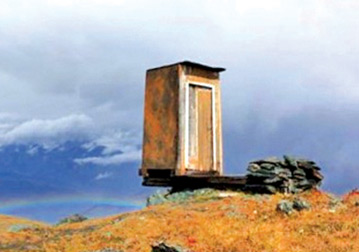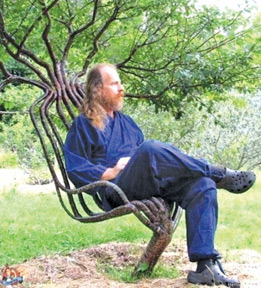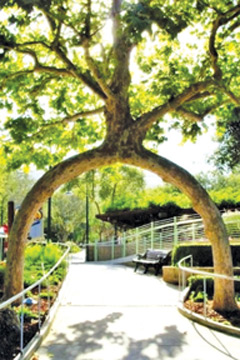|

Toilet perched on a steep hill
Just imagine having to climb 8,500 feet above sea level to go to a
toilet in an emergency! It's not just the height that makes it scary;
the toilet is perched rather precariously on the edge of a cliff. It
looks like it might fall right off if a very heavy person used it.
 What's this lonely lavatory doing up there all by itself, you ask?
Well, it's meant to serve just five people - employees at the remote
weather station at Kara-Tyurek. What's this lonely lavatory doing up there all by itself, you ask?
Well, it's meant to serve just five people - employees at the remote
weather station at Kara-Tyurek.
Kara-Tyurek, which means 'Black Heart' in the local language, lies in
the Russian Altai Mountains. Its weather station has been operational
since 1939, and the five people working there have just the one toilet
to use.
Once a month, a postman visits them to collect the weather data. A
helicopter delivers food supplies, water and wood for burning, once
every year.
According to a recently conducted extensive survey of lavatories,
"The toilet is perhaps situated in the most unromantic place possible,
but there are some parts of the world where people have made them
something really special." I suppose this Siberian rest room is one of
the special ones. The report listed it as one of the most extreme in the
world; it takes years of practice to use it without fear.
At such heights, one would just prefer going behind a rock or a bush.
Turning young trees into living works of art
 What do you know about Biotecture? You may sometimes think it as
something to do with architecture. In a way it can be linked to
architecture but it is close to sculpture. In other words we can
identify it as tree sculpture - the technique involves growing and
shaping the trunks of trees and other woody plants by grafting and
pruning. What do you know about Biotecture? You may sometimes think it as
something to do with architecture. In a way it can be linked to
architecture but it is close to sculpture. In other words we can
identify it as tree sculpture - the technique involves growing and
shaping the trunks of trees and other woody plants by grafting and
pruning.
The trunks or branches are grown into ornamental and useful shapes.
To define the process more we can describe it as the turning of trees
into living works of art.Tree branches and trunks have the unique
ability to unite together by grafting.
The new shapes are retained when fresh layers of wood grow over the
older ones. So a tree sculptor winds two or more parts of a tree
together by cutting off the bark and then binds the wounded parts
together so that the contact is secure.
This promotes the tree parts to grow together. These stems and
branches need to be wound together for at least a year depending on the
amount of resistance they need to overcome.
Additional layers of wood grow during this time, acting as a natural
cast and retaining the new desired shape. Once the shape is able to hold
itself, the bracing is removed.
The techniques used by artists vary between Instant Tree Shaping,
also known as Arborsculpture (mature trees bent into the desired shape
and held until cast), Aeroponic Culture (the use of living,
air-suspended roots to make bridges) and Gradual Tree Shaping (trees are
grown from saplings for the specific purpose of creating a design).
  The art of tree shaping is centuries old, and has its origins in the
Khasi people of India who used to build bridges made of live roots. Some
of these living root trees can be seen even today in North East India,
in Cherrapunji, Laitkynsew and Nongriat in the state of Meghalaya. The art of tree shaping is centuries old, and has its origins in the
Khasi people of India who used to build bridges made of live roots. Some
of these living root trees can be seen even today in North East India,
in Cherrapunji, Laitkynsew and Nongriat in the state of Meghalaya.
In the Middle East, living trees were used to construct houses, a
practice that spread to Europe as well.
These houses were up to three storeys tall and could accommodate
about 50 people.In the early 20th century, circus trees were made by
prominent artisan Axel Erlandson.
The Basket Tree and Needle and Thread Tree are some of his most
popular works that remain in display at the Tree Circus in California
even today. Erlandson was rather secretive and the only response he had
to questions about his trees was, "I talk to them." John Krubsack was
another famous tree sculptor of that time period.
The first known living chair was shaped and grafted by him, and
harvested in 1914. He created all kinds of found-wood furniture.
'The Chair That Lived' is his most famous work of art and is still on
display in a furniture shop owned by his descendants in Wisconsin. |

